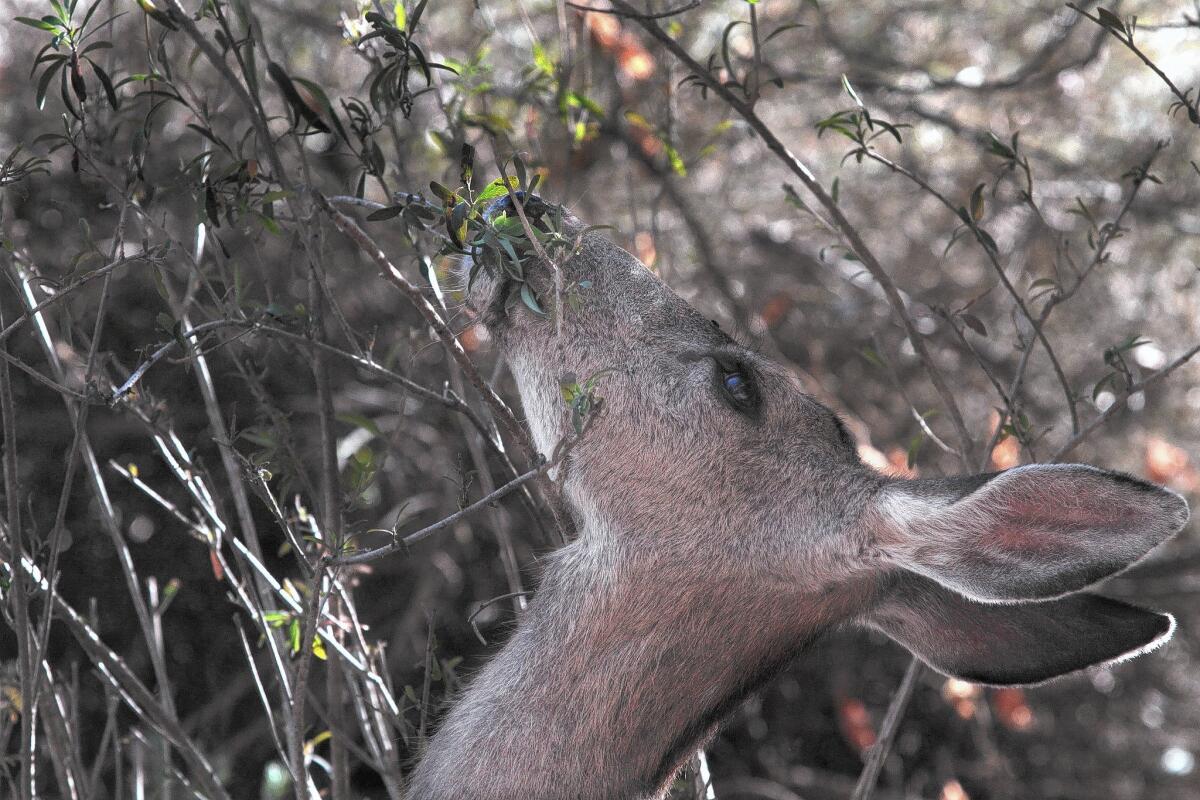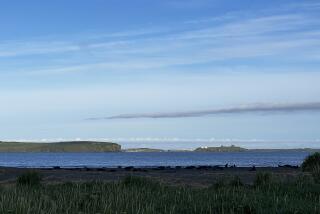Nonnative mule deer now in Catalina Island Conservancy’s cross-hairs

Over the last two decades, the conservancy that owns nine-tenths of this island has shot, trapped and shipped out thousands of goats, pigs and bison that were literally eating away the island.
Today, three female goats and a single shaggy pig remain in the rugged interior. The bison population has dropped from 350 to 138, and the remaining animals are on birth control.
Now, nonnative mule deer are in the cross-hairs.
The mule deer — whose population now stands at about 2,400 — is the most destructive invasive species left on the island, situated 22 miles south of Palos Verdes Peninsula. Prolonged drought is forcing them to take an even bigger bite out of the region’s unique vegetation.
This year, for the first time, the Catalina Island Conservancy will require that more does than bucks are taken during hunting season, which runs from July into December.
“This year, 60% of the 500 tags we issue will be for does,” John Mack, the conservancy’s conservation manager, said during a tour of mountainous terrain that deer had stripped of brush and saplings, leaving dry tufts of grass. “Since each doe annually produces twins, tagging one means you’ve removed three deer from the island that year.”
The response of shrubs to the thinned deer herds will determine whether the hunting ratio will be modified in subsequent seasons. “I think we may eventually have to go to an 80% doe-heavy harvest to reduce the population,” Mack said.
The new hunting strategy is being pursued under an agreement between the California Department of Fish and Wildlife, which owns the deer, and the nonprofit conservancy, which owns 88% of the island and is mandated to return it to its natural state.
“If nothing is done, that deer population will grow to the point where much of it will starve to death,” department biologist Rebecca Barboza said.
Typically, hunters take about 350 deer a year. Biologists say that’s not nearly enough. Reports of deer feasting on home gardens and parading down Avalon streets have soared in recent weeks.
About 20 deer routinely amble out of dry brush near Avalon’s swank Descanso Beach Club at dusk and converge on a wooden box filled with bowls of water and pet food. The food, both dry and wet, is meant primarily for feral cats, but some residents who replenish it mistakenly believe that it also helps deer.
Biologists say that isn’t true. Deer like the salt found in cat food, but it lacks vitamins and can lead to bloating and fatal digestive disorders in the herbivores, said Julie King, the conservancy’s senior biologist.
Occasionally, residents leave mounds of lettuce for the deer at the site, near a sign warning that feeding deer is “illegal and dangerous.”
Much of the cat food is put in dishes and slid into an area of the box designed to be inaccessible to deer. But King said scientists “have seen deer lay down on their sides and pull the food dishes out with their hooves.”
The first deer were shipped over by the Los Angeles County Forestry Department in the 1930s, about the time pigs were brought from Santa Cruz Island to root out rattlesnakes. Domestic goats were turned loose by Spanish missionaries in the 1820s. Bison were imported for movies in 1924.
With no predators to thin the herds, deer have competed with the island’s native wildlife for eight decades, wreaking havoc on plants, some of them found nowhere else.
Now, as the drought drags on, green saplings and chaparral are especially vulnerable to browsing deer —and crucial for the survival of the island’s ecosystem. Catalina usually gets about 12 inches of rainfall a year. But in the last 12 months it has received less than 5 inches, Avalon officials said.
Deer pose an acute threat to native plant communities after fires such as one that charred 10% of the island in 2007, according to a recent study led by Aaron Ramirez, a research biologist at UC Berkeley.
Ramirez found “extreme levels of deer browsing” in burned areas of delicate, thornless shrubs and grasses that had evolved in the presence of herbivores no larger than ground squirrels. “Both the deer and bison are causing huge problems,” he said.
Conservancy officials would not go that far. But they say Catalina’s plants and animals are on the rebound because of the removal of feral creatures, the replanting of native plants nurtured in greenhouses and laboratories, and the fencing off of sensitive areas such as acreage burned during the 2007 fire.
“We can see the light at the end of the tunnel,” Mack said. “After a few more threat reductions, we’ll be able to focus more attention on large-scale restoration projects such as planting lots and lots of native vegetation on recovering landscapes.”
[email protected]
Twitter: @LouisSahagun







